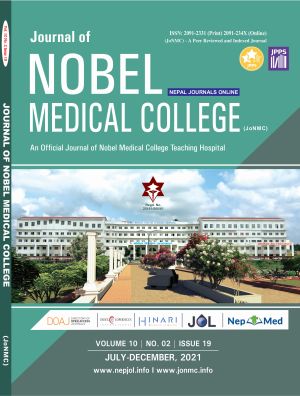Clinico-Mycological Profile of Dermatophytosis in a Tertiary Care Hospital of Eastern Nepal
DOI:
https://doi.org/10.3126/jonmc.v10i2.41565Keywords:
Dermatophytes, Tinea, TrichophytonAbstract
Background: Dermatophytes are keratinophilic and keratinolytic fungi which are responsible for dermatophytosis. There are three genera of dermatophytes; Trichophyton, Microsporum and Epidermophyton. As they have affinity to keratin rich tissue, they produce dermal inflammatory response, intense itching and cosmetically poor appearance. The varied clinical presentation of tinea results in delay in diagnosis, poor compliance in follow up of cases, and consequently spread of infection in the community has rekindled interest in rapid identification of species.
Materials and Methods: A hospital based cross sectional study was carried out in the department of Microbiology, Nobel medical college from January 2019 to December 2019. Clinically suspected 200 cases of dermatophytosis attending Out Patient Department were studied. Isolation and identification was done by various tests like macroscopic, microscopic and biochemical tests.
Results: Out of 200 specimens, 138 (69%) were skin scraping, 42 (21%) were nail clipping and 20 (10%) were hair stubs. Highest incidence was seen in the age group 21-40 years with 115 (57.5%) cases followed by 41-60 years 46 (23%) cases. In our study male preponderance of 158 (79%) and female of 42 (21%) were seen. Tinea corporis was found to be the commonest clinical type with 96 (48%) cases followed by tinea unguinum, 42 (21%), Tinea cruris 10 (11.36%), Tinea capitis 5 (5.68%), Tinea faciei 4 (4.54%), Tinea pedis 2 (2.27%). Among the fungal isolates Trichophyton rubrum (67.04%) was the most common etiological agent followed by Trichophyton mentagrophytes (13.63%), Epidermophyton 10 (11.36%), Trichophyton violaceum 4 (4.54%) and Epidermophyton floccosum 3 (3.4%).
Conclusion: The most common clinical presentation was tinea corporis followed by tinea unguinum. T. rubrum was the most common etiological agent of dermatophytosis
Downloads
Downloads
Published
How to Cite
Issue
Section
License

This work is licensed under a Creative Commons Attribution 4.0 International License.
JoNMC applies the Creative Commons Attribution (CC BY) license to works we publish. Under this license, authors retain ownership of the copyright for their content, but they allow anyone to download, reuse, reprint, modify, distribute and/or copy the content as long as the original authors and source are cited.




